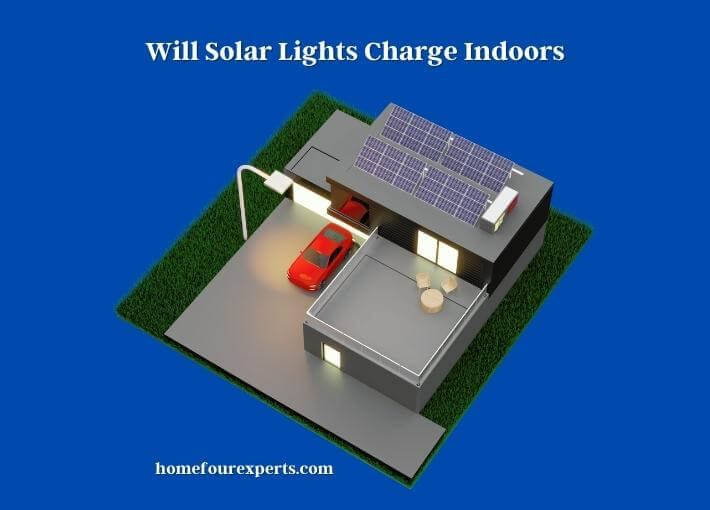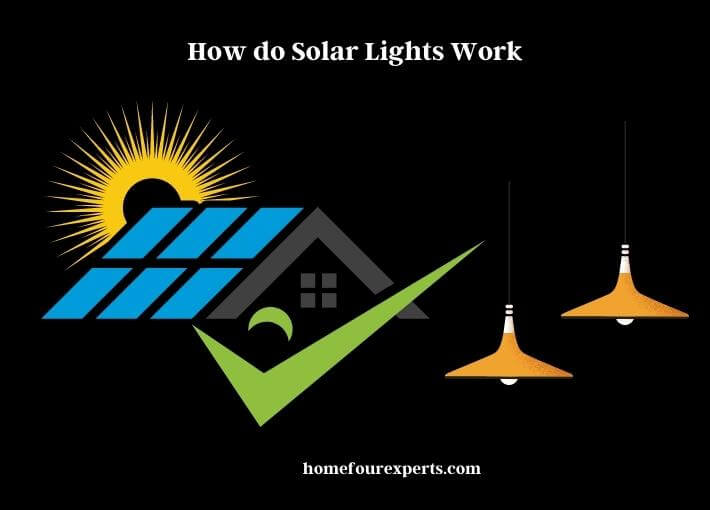Published on: March 24, 2023
Written by Liam Jaxon / Fact-checked by David Rowan
Solar lights have become increasingly popular over the years due to their cost-effectiveness and eco-friendliness. They are a type of outdoor lighting that harnesses the power of the sun to produce light at night. This means that solar lights do not require electrical wiring or electricity from the grid, which can save you money on your energy bills and reduce your carbon footprint.

In addition to being cost-effective and eco-friendly, solar lights are also easy to install and maintain. They do not require professional installation or complicated wiring, and they are often equipped with automatic sensors that turn the lights on and off depending on the amount of sunlight available.
Solar lights come in a variety of shapes and sizes, from small pathway lights to large floodlights. They are also available in different colors and brightness levels, making them ideal for a variety of outdoor lighting needs.
Before investing in solar lights, it is important to understand how they work and the factors that can affect their performance. This article will provide a detailed overview of the components of solar lights, how they charge, and the factors that can impact their performance. By understanding how solar lights work, you can make informed decisions when choosing the right solar light for your outdoor lighting needs.
How do Solar Lights Work?
Before we discuss whether solar lights can charge indoors, it’s essential to understand how they work. Solar lights use solar panels to capture sunlight and convert it into electrical energy. Solar panels are made up of photovoltaic cells that generate direct current (DC) electricity when exposed to sunlight.

The DC electricity is then sent to a rechargeable battery, where it is stored until it’s needed. The battery powers the light source, which could be LEDs, incandescent bulbs, or other lighting technologies.
Can Solar Lights Charge Indoors?
The short answer is yes; solar lights can charge indoors. However, it’s important to note that solar lights need light to charge, and the intensity, duration, and spectrum of the light will affect the charging rate and efficiency.
The Effect of Light Intensity
Solar lights need a certain amount of light intensity to charge. The intensity of the light is measured in lux, and most solar lights need at least 1000 lux to charge. To put this into perspective, a well-lit room can have between 50 to 1000 lux, while direct sunlight can provide up to 100,000 lux.
Therefore, if you want to charge solar lights indoors, you need to ensure that the room is well-lit, and that the solar panel can receive enough light intensity to charge the batteries.
The Effect of Light Spectrum
Another factor that affects solar light charging indoors is the light spectrum. Solar panels are most efficient when they receive light in the blue and red spectrum, which is the visible light spectrum. However, some indoor lights emit light in the yellow spectrum, which is less efficient for charging solar lights.
Therefore, if you want to charge solar lights indoors, you need to ensure that the light source emits light in the blue and red spectrum, such as LED lights.
The Effect of Light Duration
The duration of the light exposure also affects the charging rate of solar lights. Solar lights need several hours of direct sunlight to charge fully. However, if the light duration is shorter, the charging rate will be lower.
Therefore, if you want to charge solar lights indoors, you need to ensure that the solar panel receives enough light duration to charge the batteries fully.
Best Practices for Charging Solar Lights Indoors
If you plan on using solar lights indoors, it is important to follow some best practices to ensure that they are charged properly and perform optimally. Here are some tips to help you get the most out of your indoor solar lights:

Choose the Right Type of Indoor Lighting
As discussed earlier, not all types of indoor lighting are ideal for charging solar lights. LED light bulbs, fluorescent light bulbs, and halogen bulbs are all options for charging solar lights indoors. When choosing the right type of indoor lighting for your solar lights, consider factors such as energy efficiency, light spectrum, and heat generation.
Position the Solar Panel in a Sunny Spot
Just like outdoor solar lights, indoor solar lights require sunlight to charge. Make sure that the solar panel of your indoor solar light is positioned in a sunny spot near a window or under a skylight. This will ensure that it receives enough sunlight to charge properly.
Keep the Solar Panel Clean
Dirt, dust, and debris can block sunlight from reaching the solar panel and can reduce its ability to charge the battery. Regularly clean the solar panel with a soft cloth to remove any dirt or debris that may have accumulated on it.
Check the Battery Regularly
Check the battery of your indoor solar light regularly to ensure that it is fully charged. If the battery is not holding a charge, it may need to be replaced.
Use the Solar Light Regularly
Indoor solar lights require regular use to ensure that the battery stays charged. If you don’t use the light often, the battery may not have enough time to charge fully, which can reduce its performance.
Use the Right Type of Solar Light for Indoor Use
Not all solar lights are designed for indoor use. Make sure that the solar light you choose is designed specifically for indoor use and has the features that you need.
How to Test if Solar Lights are Charging Indoors
Solar lights are a great way to light up your home, even when you don’t have access to traditional power sources. But can solar lights charge indoors? The answer is yes, but not all types of indoor lighting are ideal for charging solar lights. To test if solar lights are charging indoors, follow these steps:
Turn off the Lights
To test if solar lights are charging indoors, you need to create a simulated darkness. Turn off all the lights in the room where the solar light is located.
Cover the Solar Panel
Cover the solar panel of the solar light with a dark cloth or material to simulate darkness. Make sure that the cloth covers the entire solar panel and that no light is able to reach the panel.
Wait a Few Minutes
Leave the solar panel covered for a few minutes. This will give the solar light time to adjust to the simulated darkness.
Remove the Cover and Turn on the Light
After a few minutes, remove the cover from the solar panel and turn on the light. If the light is bright and works properly, then the solar light is likely charging indoors. If the light is dim or does not work at all, then the solar light may not be receiving enough sunlight to charge the battery properly.
Troubleshooting
If the solar light is not charging properly indoors, there are a few things you can try. First, try using different types of indoor lighting to see if this improves the charging. LED light bulbs, fluorescent light bulbs, and halogen bulbs are all options for charging solar lights indoors. You can also try repositioning the solar panel to a sunnier spot or cleaning the solar panel to remove any dirt or debris that may be blocking the sunlight.
Types of Indoor Lighting that can Charge Solar Lights
If you want to use solar lights indoors, it is important to understand what types of indoor lighting can effectively charge them. While solar lights are designed to charge using sunlight, there are certain types of indoor lighting that can provide a similar level of energy to power the light.
LED Light Bulbs
LED light bulbs are an energy-efficient alternative to traditional incandescent bulbs. They produce light by passing an electric current through a semiconductor material, which creates light. LED light bulbs emit a spectrum of light that is similar to sunlight, making them an ideal choice for charging solar lights indoors.
Fluorescent Light Bulbs
Fluorescent light bulbs are another option for charging solar lights indoors. They work by passing an electric current through a gas-filled tube, which produces ultraviolet light. The ultraviolet light is then converted into visible light by a phosphorescent coating on the inside of the tube. While fluorescent light bulbs do not produce the same spectrum of light as sunlight or LED bulbs, they can still provide enough energy to charge solar lights indoors.
Halogen Bulbs
Halogen bulbs are a type of incandescent bulb that produces light by passing an electric current through a filament. They emit a bright, white light that is similar to sunlight, making them an ideal choice for charging solar lights indoors. However, halogen bulbs are not as energy-efficient as LED or fluorescent bulbs and can generate a lot of heat, which may affect the performance of the solar light.
Bottom Line
Solar lights are a great way to add lighting to your home without having to worry about electricity bills or wiring. However, if you want to use solar lights indoors, you need to know if they can be charged effectively using indoor lighting. While solar lights are designed to charge using sunlight, there are certain types of indoor lighting that can provide enough energy to charge them.
LED light bulbs, fluorescent light bulbs, and halogen bulbs are all options for charging solar lights indoors. LED bulbs are the most energy-efficient and emit a spectrum of light that is similar to sunlight, making them an ideal choice for charging solar lights. Fluorescent bulbs produce ultraviolet light, which can be converted into visible light, making them another good option. Halogen bulbs emit a bright, white light that is similar to sunlight but is less energy-efficient and generates more heat.
When choosing the right type of indoor lighting for your solar lights, it is important to consider factors such as energy efficiency, light spectrum, and heat generation. By selecting the right type of indoor lighting, you can ensure that your solar lights perform optimally, even when used indoors.
About This Writer

Hi, I am responsible for the 'Homeowners Power Solutions' category. My name is Liam Jaxon and a licensed technician with 7 years of experience in vehicle batteries, electrical gadgets, and home appliances. My working experience in different residential & light commercial electrical sectors and the automobile industry helped to acquire vast knowledge in this industry.